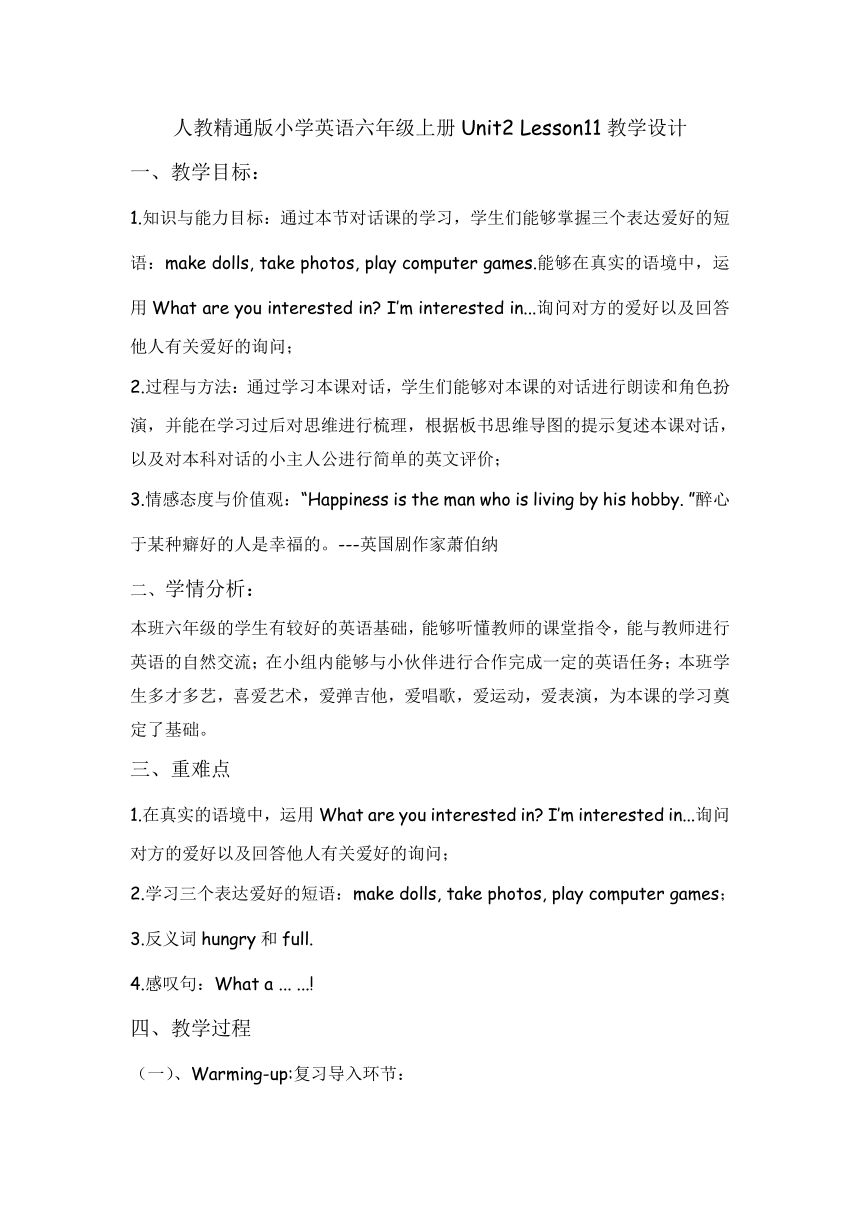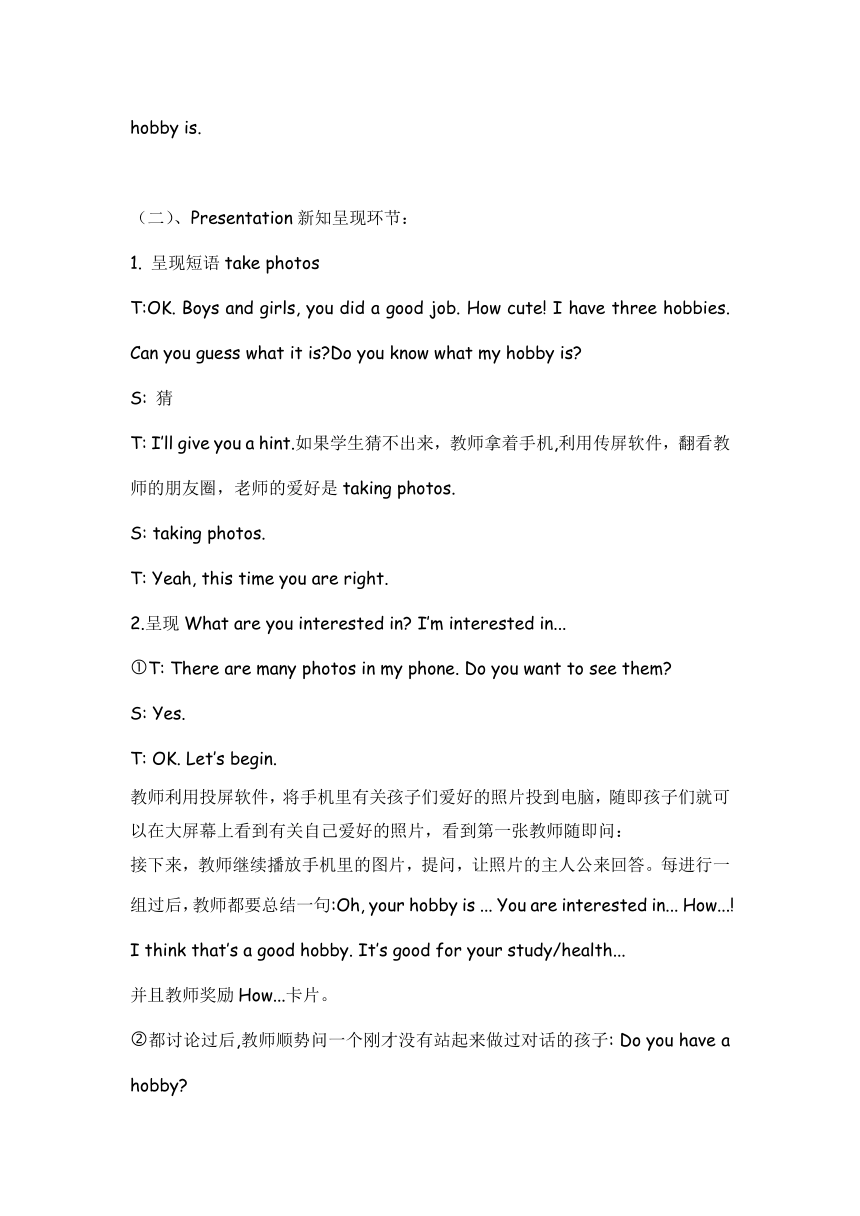Unit2 What's your hobby?(Lesson11) 教案
文档属性
| 名称 | Unit2 What's your hobby?(Lesson11) 教案 |

|
|
| 格式 | doc | ||
| 文件大小 | 37.5KB | ||
| 资源类型 | 教案 | ||
| 版本资源 | 人教精通版(三年级起点) | ||
| 科目 | 英语 | ||
| 更新时间 | 2020-11-20 14:21:38 | ||
图片预览



文档简介
人教精通版小学英语六年级上册Unit2 Lesson11教学设计
教学目标:
知识与能力目标:通过本节对话课的学习,学生们能够掌握三个表达爱好的短语:make dolls, take photos, play computer games.能够在真实的语境中,运用What are you interested in? I’m interested in...询问对方的爱好以及回答他人有关爱好的询问;
过程与方法:通过学习本课对话,学生们能够对本课的对话进行朗读和角色扮演,并能在学习过后对思维进行梳理,根据板书思维导图的提示复述本课对话,以及对本科对话的小主人公进行简单的英文评价;
情感态度与价值观:“Happiness is the man who is living by his hobby. ”醉心于某种癖好的人是幸福的。---英国剧作家萧伯纳
学情分析:
本班六年级的学生有较好的英语基础,能够听懂教师的课堂指令,能与教师进行英语的自然交流;在小组内能够与小伙伴进行合作完成一定的英语任务;本班学生多才多艺,喜爱艺术,爱弹吉他,爱唱歌,爱运动,爱表演,为本课的学习奠定了基础。
重难点
在真实的语境中,运用What are you interested in? I’m interested in...询问对方的爱好以及回答他人有关爱好的询问;
学习三个表达爱好的短语:make dolls, take photos, play computer games;
反义词hungry和full.
感叹句:What a ... ...!
四、教学过程
(一)、Warming-up:复习导入环节:
Listen and sing播放一首英文儿歌If you are happy
改编:
If you're happy and you know it, do like me, smile, smile (smile, smile).
If you're happy and you know it, do like me, smile, smile (smile, smile).
If you're happy and you know it, then your face will surely show it.
If you're happy and you know it, do like me, smile, smile. (smile, smile).
If you're sad and you know it, do like me, cry, cry (cry, cry).
If you're sad and you know it, do like me, cry, cry (cry, cry).
If you're sad and you know it, then your face will surely show it.
If you're sad and you know it, do like me, cry, cry (cry, cry).
2. Free talk
T: Are you happy today?
S: Yes,I am.
T: I am happy,too. So let’s smile together.学生和老师一起微笑,并齐声说smile。
此环节设计意图:轻松开场,让孩子们带着愉悦的心情进入本节课的英语学习,与此同时对smile和cry进行简单的渗透.
3. Today we are happy to learn a new lesson---Lesson11.教师贴标题
I have three hobbies. Now let’s have a guessing game. Guess what my first hobby is.
(二)、Presentation新知呈现环节:
呈现短语take photos
T:OK. Boys and girls, you did a good job. How cute! I have three hobbies. Can you guess what it is?Do you know what my hobby is?
S: 猜
T: I’ll give you a hint.如果学生猜不出来,教师拿着手机,利用传屏软件,翻看教师的朋友圈,老师的爱好是taking photos.
S: taking photos.
T: Yeah, this time you are right.
呈现What are you interested in? I’m interested in...
T: There are many photos in my phone. Do you want to see them?
S: Yes.
T: OK. Let’s begin.
教师利用投屏软件,将手机里有关孩子们爱好的照片投到电脑,随即孩子们就可以在大屏幕上看到有关自己爱好的照片,看到第一张教师随即问:
接下来,教师继续播放手机里的图片,提问,让照片的主人公来回答。每进行一组过后,教师都要总结一句:Oh, your hobby is ... You are interested in... How...! I think that’s a good hobby. It’s good for your study/health...
并且教师奖励How...卡片。
都讨论过后,教师顺势问一个刚才没有站起来做过对话的孩子: Do you have a hobby?
学生回答: Yes.
T:What’s your hobby?
孩子自由回答My hobby is...在这个过程中,教师追问: Why do you like...?让孩子们自由表达观点.之后教师总结一句,How...! 并奖励卡片,然后顺势问另一个孩子:Are you interested in...刚才那个孩子提到的爱好?
S: Yes.教师就问Do you have a different hobby? 如果孩子回答No.那么教师就可以直接问了:What are you interested in?
孩子回答:I’m interested in ...教师板书
3.操练What are you interested in? I’m interested in...
T: Now boys and girls, would you please work in pairs and have a talk about the hobbies of each other with these two sentences:What are you interested in?I’m interested in ...
这个环节的设计意图旨在操练本课重点句型,也是为后面的拓展环节做铺垫,为孩子们的语言输出铺路.
4. Guess the second hobby of the teacher.
图片,上面是一个小宝宝带耳麦听音乐,让学生们猜一猜老师的爱好,引导学生用这样的语言:Maybe you’re interested in...(打到PPT上)可能有的孩子会猜listening to music但其实老师的爱好是taking care of the baby,板书并朗读take care of the baby
教师在这里提一个问题: What else should we take care of?
学生们自由回答: We should take care of old people/our body/our parents/our friends/eyes.
教师评价: Since you are all good children, You are so clever. I’ll surely give you a smiling face this time. OK,let’s smile together.这次奖励完了每个单独的孩子以后,在新的一页的幻灯片里打出一个笑脸作为集体性的奖励。
(三)、Practice操练巩固环节
刚才的大的笑脸消失,展示今天新课的图片
T: Look at this photo. Let’s see who comes.带着学生们看图,熟悉本课的主人公.让孩子们先通过观察图片,Can you talk about the picture?放手让孩子们自由发挥描述在图里看到了什么.
描述图片2&3的时候,引导孩子们区分baby and kid 用英文释义,教师上网示范查找两个词的英文释义,最后总结 a kid means a child, he or she can eat, think or take care of others. But a baby cannot do that.
T: look at this picture, what do you think is the baby doing?
S: the baby is crying.
T: why is he crying? Can you guess?
S: guess
T: Maybe you’re right. How about the kid? What is she doing? Is she crying, too?
S: No.
T: we can say she is feeding the baby.教师在相应的位置进行板书feeding the baby. What else do we usually feed?教师可以给图,让孩子们说feed the...可以出示几张图片,也可以让孩子们自己发挥.
And then the baby is happy. Right?
Now this time let’s check whether we’re right or not.
带着问题听录音并回答问题:先自己大声读一遍,回答这是对话的主要内容是什么?
然后回答:
1). Is Zhou Pei making a cake?
2). What is Yang Ming interested in?
3). Is Lisa interested in playing computer games or taking photos?
4). Why is the baby crying? And why is he smiling at last最后?
T播放录音,孩子们听录音并做答.
Check the answer.给出原对话的出处作为依据.在这个过程中,处理hungry与full
hungry:让学生表演 full:打嗝的声音
并且补全板书(思维导图)
4.听录音,跟读,分角色朗读(1组展示,看着黑板上的板书提示更好)
5. What do you think of the kid?
6.根据板书思维导图的内容,复述本课对话内容。
(四)、Production生成拓展环节
1.让学生们在自己的小组内写自己的爱好Our hobbies,制作自己组的“Hobby Album”.
统计谁没有How...的卡片,引导孩子们到黑板上去拿,有卡片的提示孩子们可以在写作的时候参考卡片的背面,然后展示两位学生的作品,投影仪投影或者传屏软件.
2.T: So can you figure out what my third hobby is?教师让学生猜自己最后一个爱好是什么。也就是老师的最后一个爱好,可以让学生大胆地猜wild guess,应该不会有学生猜得到,让学生们打开,里面是一块黑板和English:I'm interested in teaching you English, teaching you how to learn more about the foreign culture. When I am with you, I can feel the happiness deeply in my heart. Above all we should have hobbies. We should have good hobbies, because “Happiness is the man who is living by his hobby. ”醉心于某种癖好的人是幸福的。 ---英国剧作家萧伯纳
PPT播放最后一句话:“Happiness is the man who is living by his hobby. ”进行情感教育。
教学目标:
知识与能力目标:通过本节对话课的学习,学生们能够掌握三个表达爱好的短语:make dolls, take photos, play computer games.能够在真实的语境中,运用What are you interested in? I’m interested in...询问对方的爱好以及回答他人有关爱好的询问;
过程与方法:通过学习本课对话,学生们能够对本课的对话进行朗读和角色扮演,并能在学习过后对思维进行梳理,根据板书思维导图的提示复述本课对话,以及对本科对话的小主人公进行简单的英文评价;
情感态度与价值观:“Happiness is the man who is living by his hobby. ”醉心于某种癖好的人是幸福的。---英国剧作家萧伯纳
学情分析:
本班六年级的学生有较好的英语基础,能够听懂教师的课堂指令,能与教师进行英语的自然交流;在小组内能够与小伙伴进行合作完成一定的英语任务;本班学生多才多艺,喜爱艺术,爱弹吉他,爱唱歌,爱运动,爱表演,为本课的学习奠定了基础。
重难点
在真实的语境中,运用What are you interested in? I’m interested in...询问对方的爱好以及回答他人有关爱好的询问;
学习三个表达爱好的短语:make dolls, take photos, play computer games;
反义词hungry和full.
感叹句:What a ... ...!
四、教学过程
(一)、Warming-up:复习导入环节:
Listen and sing播放一首英文儿歌If you are happy
改编:
If you're happy and you know it, do like me, smile, smile (smile, smile).
If you're happy and you know it, do like me, smile, smile (smile, smile).
If you're happy and you know it, then your face will surely show it.
If you're happy and you know it, do like me, smile, smile. (smile, smile).
If you're sad and you know it, do like me, cry, cry (cry, cry).
If you're sad and you know it, do like me, cry, cry (cry, cry).
If you're sad and you know it, then your face will surely show it.
If you're sad and you know it, do like me, cry, cry (cry, cry).
2. Free talk
T: Are you happy today?
S: Yes,I am.
T: I am happy,too. So let’s smile together.学生和老师一起微笑,并齐声说smile。
此环节设计意图:轻松开场,让孩子们带着愉悦的心情进入本节课的英语学习,与此同时对smile和cry进行简单的渗透.
3. Today we are happy to learn a new lesson---Lesson11.教师贴标题
I have three hobbies. Now let’s have a guessing game. Guess what my first hobby is.
(二)、Presentation新知呈现环节:
呈现短语take photos
T:OK. Boys and girls, you did a good job. How cute! I have three hobbies. Can you guess what it is?Do you know what my hobby is?
S: 猜
T: I’ll give you a hint.如果学生猜不出来,教师拿着手机,利用传屏软件,翻看教师的朋友圈,老师的爱好是taking photos.
S: taking photos.
T: Yeah, this time you are right.
呈现What are you interested in? I’m interested in...
T: There are many photos in my phone. Do you want to see them?
S: Yes.
T: OK. Let’s begin.
教师利用投屏软件,将手机里有关孩子们爱好的照片投到电脑,随即孩子们就可以在大屏幕上看到有关自己爱好的照片,看到第一张教师随即问:
接下来,教师继续播放手机里的图片,提问,让照片的主人公来回答。每进行一组过后,教师都要总结一句:Oh, your hobby is ... You are interested in... How...! I think that’s a good hobby. It’s good for your study/health...
并且教师奖励How...卡片。
都讨论过后,教师顺势问一个刚才没有站起来做过对话的孩子: Do you have a hobby?
学生回答: Yes.
T:What’s your hobby?
孩子自由回答My hobby is...在这个过程中,教师追问: Why do you like...?让孩子们自由表达观点.之后教师总结一句,How...! 并奖励卡片,然后顺势问另一个孩子:Are you interested in...刚才那个孩子提到的爱好?
S: Yes.教师就问Do you have a different hobby? 如果孩子回答No.那么教师就可以直接问了:What are you interested in?
孩子回答:I’m interested in ...教师板书
3.操练What are you interested in? I’m interested in...
T: Now boys and girls, would you please work in pairs and have a talk about the hobbies of each other with these two sentences:What are you interested in?I’m interested in ...
这个环节的设计意图旨在操练本课重点句型,也是为后面的拓展环节做铺垫,为孩子们的语言输出铺路.
4. Guess the second hobby of the teacher.
图片,上面是一个小宝宝带耳麦听音乐,让学生们猜一猜老师的爱好,引导学生用这样的语言:Maybe you’re interested in...(打到PPT上)可能有的孩子会猜listening to music但其实老师的爱好是taking care of the baby,板书并朗读take care of the baby
教师在这里提一个问题: What else should we take care of?
学生们自由回答: We should take care of old people/our body/our parents/our friends/eyes.
教师评价: Since you are all good children, You are so clever. I’ll surely give you a smiling face this time. OK,let’s smile together.这次奖励完了每个单独的孩子以后,在新的一页的幻灯片里打出一个笑脸作为集体性的奖励。
(三)、Practice操练巩固环节
刚才的大的笑脸消失,展示今天新课的图片
T: Look at this photo. Let’s see who comes.带着学生们看图,熟悉本课的主人公.让孩子们先通过观察图片,Can you talk about the picture?放手让孩子们自由发挥描述在图里看到了什么.
描述图片2&3的时候,引导孩子们区分baby and kid 用英文释义,教师上网示范查找两个词的英文释义,最后总结 a kid means a child, he or she can eat, think or take care of others. But a baby cannot do that.
T: look at this picture, what do you think is the baby doing?
S: the baby is crying.
T: why is he crying? Can you guess?
S: guess
T: Maybe you’re right. How about the kid? What is she doing? Is she crying, too?
S: No.
T: we can say she is feeding the baby.教师在相应的位置进行板书feeding the baby. What else do we usually feed?教师可以给图,让孩子们说feed the...可以出示几张图片,也可以让孩子们自己发挥.
And then the baby is happy. Right?
Now this time let’s check whether we’re right or not.
带着问题听录音并回答问题:先自己大声读一遍,回答这是对话的主要内容是什么?
然后回答:
1). Is Zhou Pei making a cake?
2). What is Yang Ming interested in?
3). Is Lisa interested in playing computer games or taking photos?
4). Why is the baby crying? And why is he smiling at last最后?
T播放录音,孩子们听录音并做答.
Check the answer.给出原对话的出处作为依据.在这个过程中,处理hungry与full
hungry:让学生表演 full:打嗝的声音
并且补全板书(思维导图)
4.听录音,跟读,分角色朗读(1组展示,看着黑板上的板书提示更好)
5. What do you think of the kid?
6.根据板书思维导图的内容,复述本课对话内容。
(四)、Production生成拓展环节
1.让学生们在自己的小组内写自己的爱好Our hobbies,制作自己组的“Hobby Album”.
统计谁没有How...的卡片,引导孩子们到黑板上去拿,有卡片的提示孩子们可以在写作的时候参考卡片的背面,然后展示两位学生的作品,投影仪投影或者传屏软件.
2.T: So can you figure out what my third hobby is?教师让学生猜自己最后一个爱好是什么。也就是老师的最后一个爱好,可以让学生大胆地猜wild guess,应该不会有学生猜得到,让学生们打开,里面是一块黑板和English:I'm interested in teaching you English, teaching you how to learn more about the foreign culture. When I am with you, I can feel the happiness deeply in my heart. Above all we should have hobbies. We should have good hobbies, because “Happiness is the man who is living by his hobby. ”醉心于某种癖好的人是幸福的。 ---英国剧作家萧伯纳
PPT播放最后一句话:“Happiness is the man who is living by his hobby. ”进行情感教育。
同课章节目录
- Unit 1 I go to school at 8:00.
- Lesson 1
- Lesson 2
- Lesson 3
- Lesson 4
- Lesson 5
- Lesson 6
- Unit 2 What's your hobby?
- Lesson 7
- Lesson 8
- Lesson 9
- Lesson 10
- Lesson 11
- Lesson 12
- Unit 3 Would you like to come to my birthday party
- Lesson 13
- Lesson 14
- Lesson 15
- Lesson 16
- Lesson 17
- Lesson 18
- Fun Time 1
- Recycle 1
- Recycle 2
- Fun Reading
- Unit 4 January is the first month.
- Lesson 19
- Lesson 20
- Lesson 21
- Lesson 22
- Lesson 23
- Lesson 24
- Unit 5 July is the seventh month.
- Lesson 25
- Lesson 26
- Lesson 27
- Lesson 28
- Lesson 29
- Lesson 30
- Unit 6 There are four seasons in a year.
- Lesson 31
- Lesson 32
- Lesson 33
- Lesson 34
- Lesson 35
- Lesson 36
- Fun Time 2
- Recycle 1
- Recycle 2
- Fun Reading
